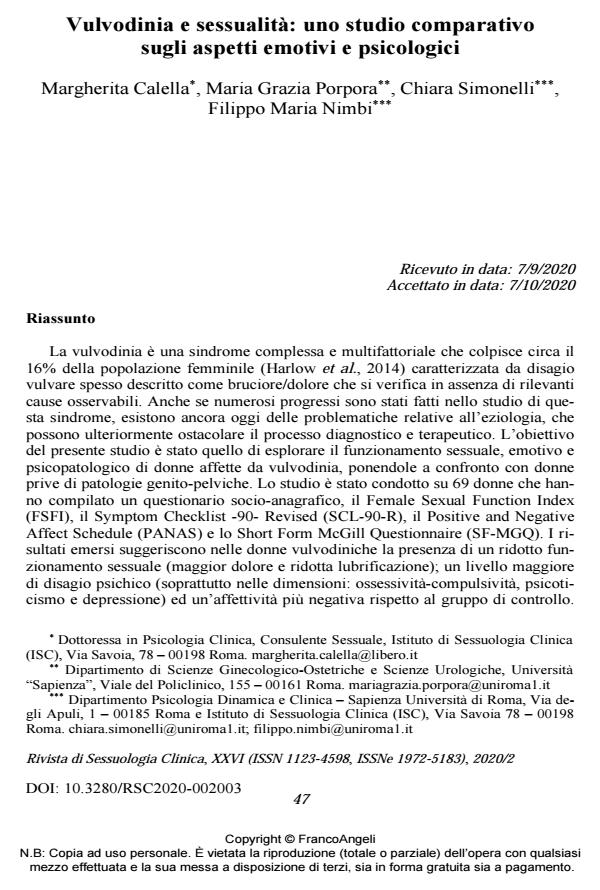Vulvodinia e sessualità: uno studio comparativo sugli aspetti emotivi e psicologici
Titolo Rivista RIVISTA DI SESSUOLOGIA CLINICA
Autori/Curatori Margherita Calella, Maria Grazia Porpora, Chiara Simonelli, Filippo Maria Nimbi
Anno di pubblicazione 2020 Fascicolo 2020/2
Lingua Italiano Numero pagine 18 P. 47-64 Dimensione file 267 KB
DOI 10.3280/RSC2020-002003
Il DOI è il codice a barre della proprietà intellettuale: per saperne di più
clicca qui
Qui sotto puoi vedere in anteprima la prima pagina di questo articolo.
Se questo articolo ti interessa, lo puoi acquistare (e scaricare in formato pdf) seguendo le facili indicazioni per acquistare il download credit. Acquista Download Credits per scaricare questo Articolo in formato PDF

FrancoAngeli è membro della Publishers International Linking Association, Inc (PILA)associazione indipendente e non profit per facilitare (attraverso i servizi tecnologici implementati da CrossRef.org) l’accesso degli studiosi ai contenuti digitali nelle pubblicazioni professionali e scientifiche
La vulvodinia è una sindrome complessa e multifattoriale che colpisce circa il 16% della popolazione femminile (Harlow et al., 2014) caratterizzata da disagio vulvare spesso descritto come bruciore/dolore che si verifica in assenza di rilevanti cause osservabili. Anche se numerosi progressi sono stati fatti nello studio di que-sta sindrome, esistono ancora oggi delle problematiche relative all’eziologia, che possono ulteriormente ostacolare il processo diagnostico e terapeutico. L’obiettivo del presente studio è stato quello di esplorare il funzionamento sessuale, emotivo e psicopatologico di donne affette da vulvodinia, ponendole a confronto con donne prive di patologie genito-pelviche. Lo studio è stato condotto su 69 donne che hanno compilato un questionario socio-anagrafico, il Female Sexual Function In-dex (FSFI), il Symptom Checklist -90- Revised (SCL-90-R), il Positive and Negati-ve Affect Schedule (PANAS) e lo Short Form McGill Questionnaire (SF-MGQ). I risultati emersi suggeriscono nelle donne vulvodiniche la presenza di un ridotto funzionamento sessuale (maggior dolore e ridotta lubrificazione); un livello maggiore di disagio psichico (soprattutto nelle dimensioni: ossessività-compulsività, psicoticismo e depressione) ed un’affettività più negativa rispetto al gruppo di con-trollo. Approfondimenti futuri potrebbero contribuire ad una migliore comprensio-ne dell’impatto che tale sindrome produce sul benessere sessuale e sulla qualità della vita delle donne che ne sono affette, indirizzando gli specialisti verso forme d’intervento multidisciplinare, che secondo il modello bio-psico-sociale, potrebbero essere più appropriate ed efficaci.
Parole chiave:Vulvodinia, dolore genito pelvico, funzionamento sessuale, funzio-namento psicopatologico, aspetti emotivi, modello bio-psico-sociale.
Margherita Calella, Maria Grazia Porpora, Chiara Simonelli, Filippo Maria Nimbi, Vulvodinia e sessualità: uno studio comparativo sugli aspetti emotivi e psicologici in "RIVISTA DI SESSUOLOGIA CLINICA" 2/2020, pp 47-64, DOI: 10.3280/RSC2020-002003